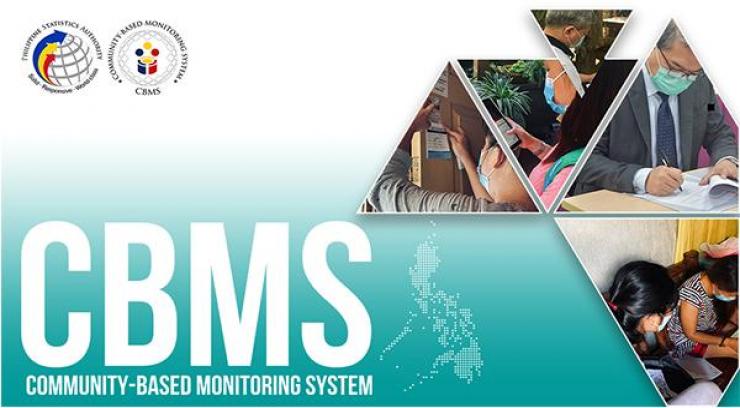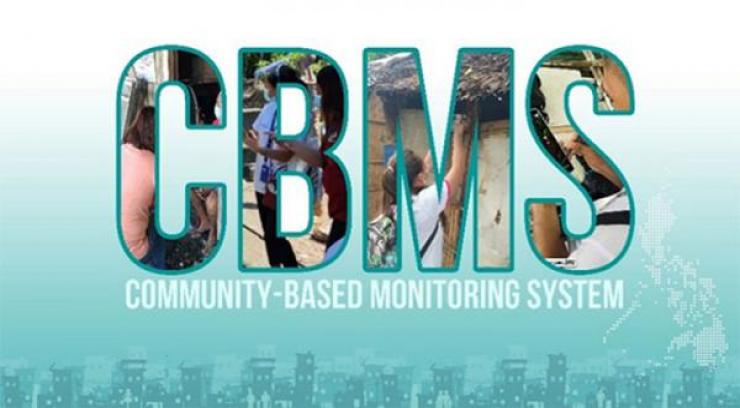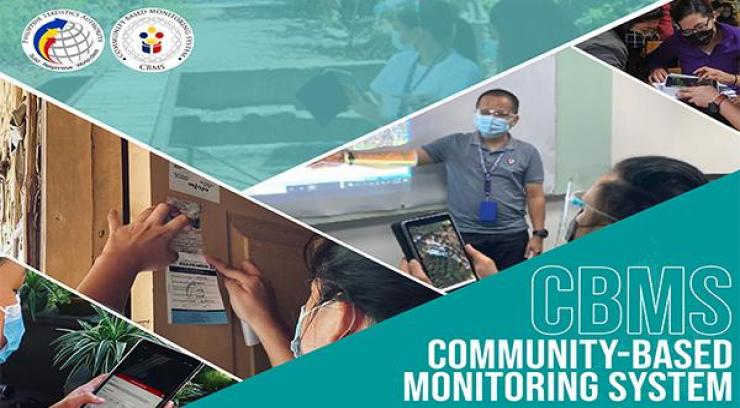Frequently Asked Questions
1. Q: How often will the CBMS be conducted?
A: Pursuant to Republic Act No. 11315, regular and synchronized data collection shall be conducted by every city and municipality every three (3) years. The law also states that local government units in the cities and municipalities may collect data through the CBMS at shorter intervals at their own expense for purposes peculiarly useful to them.
2. Q: What are the Statistics that could be generated from the CBMS?
A: CBMS shall serve as an economic and social tool towards the formulation and implementation of poverty alleviation and development programs which are specific, targeted and responsive to the basic needs of each sector of the community. In this regard, the PSA is mandated to release the Multidimensional Poverty Index and poverty statistics at the cities and municipalities using the CBMS data. Recognizing the comprehensiveness of the CBMS and the different dimensions of poverty, the CBMS will also be generating statistics on key indicators on health, nutrition, housing, water and sanitation, education, income, employment, among others.
3. Q: What are the uses of CBMS data?
A: CBMS was born as early as 1990s as part of the Micro Impacts of Macroeconomic Adjustment Policies (MIMAP) Project-Philippines as a development project under the CBMS Network Philippines. MIMAP then aims to provide policymakers and program implementers with basis for tracking the impacts of macroeconomic reforms and various policy shocks.
Since 2000, CBMS has been adopted by the Local Government Units (LGUs) through the authority of various issuances from government agencies such as the Department of the Interior and Local Government (DILG), National Anti-Poverty Commission (NAPC), and National Statistical Coordination Board (NSCB). Thus, the usefulness of CBMS data in the local level planning, budgeting, poverty diagnosis, disaster risk reduction and management (DRRM), gender and development, Millennium Development Goals progress monitoring, and project impact monitoring was recognized. Hence, LGUs that were able to secure funds to implement CBMS do so for the above-mentioned gains, not to mention the facilitation in coming up with evidence-based plans like comprehensive land use plan, local poverty reduction plan, local shelter plan, local DRRM plan, etc. Per DILG monitoring, CBMS to date, has been implemented in more than two-thirds of all cities and municipalities in the country (at least once in the past).
The institutionalization of the CBMS by virtue of RA 11315 or the CBMS Act will enable the synchronized and standardized implementation of CBMS across all cities and municipalities in the country to ensure the generation of updated and disaggregated data necessary in targeting beneficiaries, conducting more comprehensive analysis and needs prioritization, designing appropriate policies and interventions, and monitoring impact over time – all towards the fulfillment of the State Policy to uplift people out of poverty.
4. Q: What are the functions of the PSA in relation to CBMS implementation?
A: The PSA shall lead the implementation of the CBMS, under the Rule VI of the CBMS Act IRR, the PSA shall have the following functions:
a. Set statistical standards in the implementation of the CBMS and ensure that the same are properly observed;
b. Capacitate the cities and municipalities in the collection of poverty data to the local level pursuant to Rule IV of this IRR;
c. Develop and review data collection forms utilizing as base of existing CBMS forms used by LGUs;
d. Conduct cross-posting as follow-up capacity building of the cities and municipalities;
e. Monitor the data collection by cities and municipalities to ensure adherence to official concepts, definitions, and standards of poverty statistics;
f. Act as the national repository of all poverty data collected by the cities and municipalities;
g. Process the poverty data gathered and submitted by the cities and municipalities;
h. Generate poverty statistics at higher levels that will complement and supplement the local level data;
i. Set the qualification standards for the hiring of provincial/cities/municipalities statisticians in accordance with the Civil Service Commission Rules and Regulations;
j. Set the qualification standards for the hiring of data collectors and processors;
k. Ensure Synchronized CBMS implementation including providing the timetable of operations;
l. Undertake measures to ensure integrity, security, and safety of the gathered information against unnecessary leakage and access by unauthorized persons; and
m. Perform such other functions as may be necessary or incidental to the proper implementation of the Act.
5. Q: What is the involvement of the LGUs in the CBMS implementation?
A: Under RA 11315 IRR, cities and municipalities are to serve as the primary data collecting authority. In particular, they shall:
(a) Conduct synchronized data collection on CBMS every three (3) years with the necessary financial and technical assistance from the appropriate national government agencies pursuant to Section 5 of the CBMS Act;
(b) Utilize CBMS generated data in local governance processes such as but not limited to local planning, investment programming, budgeting, program identification and implementation, as well as disaster risk reduction and management measures;
(c) Designate/appoint city/municipal statistician pursuant to Section 4 of the CBMS Act;
(d) Generate and submit all CBMS data gathered to PSA;
(e) Participate in CBMS-related advocacy, training and capacity-building; and
(f) Share CBMS data in accordance with the data sharing guidelines issued by the CBMS Council and existing laws, rules and regulations.
Meanwhile, provinces shall utilize CBMS generated data in local governance processes such as but not limited to local planning, investment programming, budgeting, program identification and implementation, as well as disaster risk reduction and management measures.
6. Q: How are different sectors involved in CBMS implementation?
A: Various sectors are directly involved in the CBMS implementation to include:
Philippine Statistical Research and Training Institute (PSRTI), Department of the Interior and Local Government (DILG), Department of Information and Communications Technology (DICT), State Universities and Colleges (SUCs), CBMS Network, Community Organizations, among others.
-
The PSRTI, as the research and training arm of the Philippine Statistical System, shall spearhead the development and implementation of capacity building and research program of the CBMS.
-
The DILG is tasked to develop and implement information and educational campaign relating to CBMS, ensure compliance of the LGUs in the various CBMS activities, and shall extend assistance to PSA in the conduct and implementation of the CBMS.
-
The DICT, as the primary policy, planning, coordinating, implementing, and administrative entity of the Executive Branch of the government that plans, develops, and promotes the national ICT development agenda, shall provide technical assistance in the development and maintenance of CBMS Portal and CBMS Databank; develop, in collaboration with the National Privacy Commission, the institutional arrangements on data sharing between the CBMS Council and relevant national government agencies; and conduct capacity building on the use and operation of the CBMS Portal and Databank/Database.
-
The SUCs shall be involved in the capacity building activities for LGUs on CBMS data collection and processing and other trainings for data analysis and presentation of CBMS data in accordance with Section 6.b of the CBMS Act.
-
The CBMS Network and national government agencies that presently conduct CBMS shall share their respective tools during the transition period, such as but not limited to: questionnaire; technical, operations and other manuals; systems for data capture, processing, tabulation, evaluation, analysis, and dissemination; database design and development tools; web-based data analytics and visualization tool; and report writing templates.
-
Community organizations as advocates of the CBMS and as possible participants in providing complementary information in CBMS implementation.
7. Q: What is the National CBMS Databank?
A: The National CBMS Databank pertains to a database that would be generated with the great number of information from the conduct of CBMS implementation. This would contain all aggregated individual-, household-, and community-level data.
8. Q: How will CBMS be implemented in the transition period?
A: Section 1, Rule XIII of the IRR states that the national government agencies which collect poverty data for purposes of targeting deserving beneficiaries to their respective social protection programs shall continue to perform their duties and responsibilities in a hold over capacity for a period of one (1) year from the effectivity of the implementing rules and regulations, or for such period as may be determined by the PSA to ensure compliance with the requirements of the CBMS Act.
The CBMS Network and national government agencies that presently conduct the CBMS shall share to PSA their respective tools during the transition period, such as but not limited to:
(a) Questionnaires
(b) Technical, operations, and other manuals
(c) Systems for data capture, processing, tabulation, evaluation, analysis, and dissemination
(d) Database design and development tools
(e) Web-based data analytics and visualization tools, and
(f) Report writing templates.
Section 2, Rule XIII of the IRR provides information on how the CBMS Network and national government agencies can collaborate with PSA during the transition period. In particular, they shall:
(a) Provide capacity building support on the CBMS methodology and existing CBMS tools;
(b) Share training modules on tablet-based data collection, data processing and mapping; and
(c) Assist PSA in the development of new modules on use of CBMS data for planning and program implementation such as Disaster Risk Reduction and Management (DRRM).





